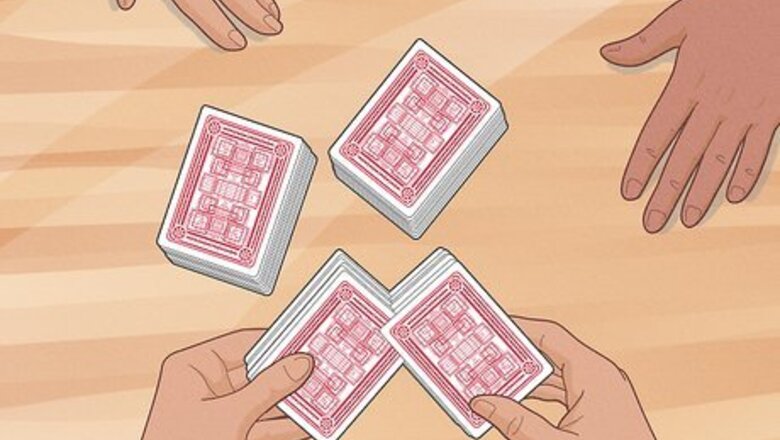
views
- Number of players: 4-6 (individual or teams of 2)
- Objective: Earn points by laying off your cards into “melds” or groups on the table.
- Setup: Gather a full deck for each player, shuffle them together, and deal each player 2 piles of 11 cards.
Dealing the Cards
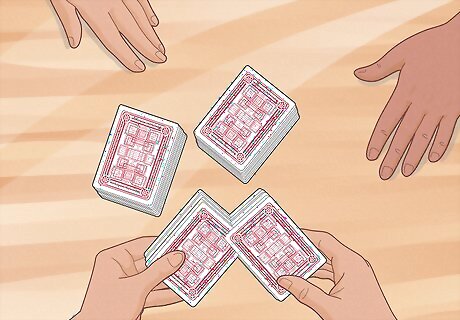
Gather and shuffle together a 52-card deck for each player at the table. Hand and foot is played with 4-6 players. Add a full deck of cards to the game for each player at the table (e.g. if you’re playing with 4 players, use 4 decks), then shuffle together all the decks to make 1 large deck. This large deck is referred to as the “stock.” Since Hand and Foot is played with many cards at once, start by shuffling each deck independently. Then, shuffle 2 decks together, divide the 2 shuffled decks in half, and shuffle them with other shuffled decks to thoroughly mix up the cards.
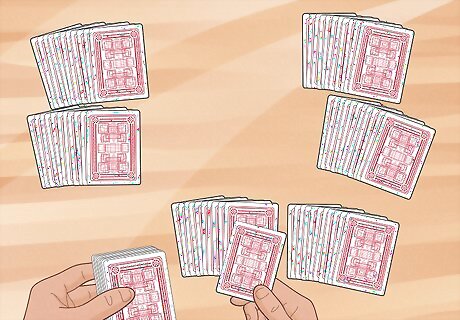
Deal 11 cards to each player, twice. Working clockwise around the table, deal cards face-down until each player has a stack of 11 cards in front of them. Instruct players to keep these cards face-down in a stack—no peeking! This first stack is known as the “foot,” and each player will use their foot later in the game. Then, deal each player a “hand”—another 11 cards—and allow them to examine them. These are the cards players will use first. If you're playing with teams (2 players to a team), have team members sit across from each other at the table during the deal, and as they play the game. Some variations of the game have players try to take stacks of exactly 22 cards from the deck instead of a deal. If they’re successful, they earn 300 points right away.
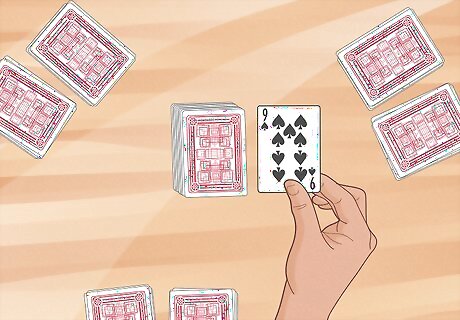
Turn over the top card of the stock to create a discard pile. Place the stock in the center of the table, then turn over the stock’s top card and place it next to the stock. This face-up card begins the discard, where players will discard 1 card after their turn, and optionally take new cards at the start of their turns.
Playing the Game

Draw 2 cards from the stock and check your hand for sets of at least 3. The person to the left of the dealer begins the game. Draw 2 cards from the stock at the center of the table, and incorporate them into your hand (ignoring your foot cards for now). Examine your hand for possible melds (sets of at least 3 cards of the same value). Or, instead of drawing 2 cards from the stock, draw 5 cards from the discard pile (or the entire discard, if there are fewer than 5 cards).
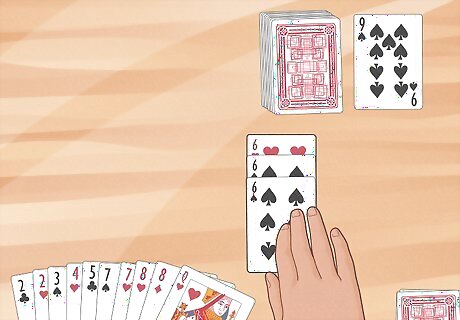
Create a new “meld” on the table, or add cards to existing melds. The object of Hand and Foot is to play all the cards in your hand and foot piles, and to do that, players make “melds” in the center of the table. To make a meld, place at least 3 cards of the same value in the center of the table (such as three 6s). Or, you may add cards from your hand onto existing melds of the same value, if there are any on the table. Note that melding in Hand and Foot comes with a fairly in-depth set of its own rules and procedures. For complete guidelines, see the Melding Section of this article. A player may only make new melds or lay cards onto their own existing melds, but not both. If laying cards onto existing melds, they may lay cards into multiple melds. If you’re playing with teams, teammates may only add new cards onto their teammate’s or their own melds.

Pick up and play with your foot pile when your hand runs out. Immediately after you discard or meld the last card in your hand, pick up your face-down foot pile and use it to play the game as normal. If you use up your hand in the middle of your turn, your turn continues using your foot pile. That said, if you use up your hand by discarding, your turn ends immediately, and you’ll use your foot pile on your next and subsequent turns.

Discard 1 card and continue playing until a player has no cards. After playing cards into melds, discard any card from your hand into the face-up discard pile. Then, the person to your left takes their turn, making melds or laying cards. Continue taking turns clockwise around the table until 1 player discards or melds their last card. If you’re playing with teams, keep playing until the second partner has played at least 1 card from their foot pile.

Tally your score, shuffle and deal the cards, and play 3 more rounds. After a player has gotten rid of all their cards, count up your score. Then, gather and shuffle all the cards together, and deal 22 cards to each player as before. Hand and Foot is played in 4 rounds, so play 3 more rounds in the same way you played the first. Whoever has the most points at the end of round 4 wins the game!
Melding
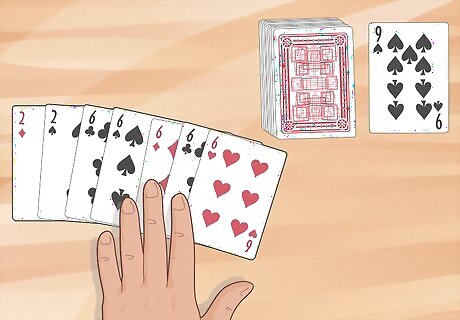
Create melds of certain values each round. In each of the 4 rounds, the cards of a player’s (or team’s) first meld played that round must add up to at least 50 points in the first round, 90 points in the second round, 120 points in the third, and 150 points in the fourth round. After this first meld is made, new melds by that player or team don’t need to add up to any certain value. Players may reach the point threshold with multiple melds, if they choose. Card values are as follows: 4-7: 5 points 8-Kings: 10 points Aces & 2: 20 points Jokers: 50 points 3s cannot be melded. Wild cards (jokers and 2s) may be played in place of any other card.
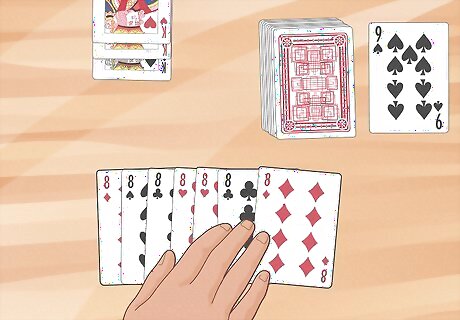
Complete melds of 7 cards, which are known as “books.” Once a player or a team has created a meld of 7 cards, that meld is set aside and becomes a completed “book.” New cards cannot be added to completed books. A book that was made with no wild cards is called a “clean” book and is worth 500 points at the end of the round, while one made with wild cards, which is known as a “dirty” book, is worth 300. Once you make a book, stack the cards into a pile and set them aside. Place a red card from the meld face-up on top if it’s a clean meld, or a black card if it’s a dirty meld, to help you tell them apart later. Because dirty melds are easier to play, usually it's wise to save these plays for later in the game.
Scoring the Game
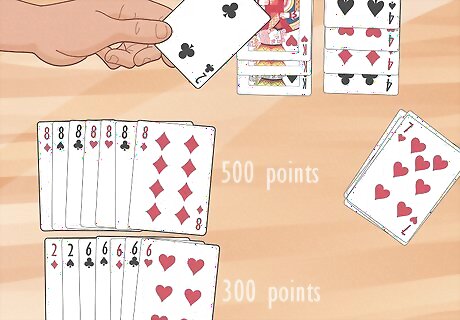
Win points for each meld after someone gets rid of all their cards. Immediately after someone gets rid of the last card of their foot pile, either with a meld or a discard, end the round and tally the score. Each team earns points for the melds they turned into books: 500 points for each clean book and 300 points for each dirty book. This is your base score. The player or team who got rid of their cards, or “went out,” also gets an extra 300 points.

Add points to your score from each melded card. You also win points for each card you melded, even if they’re already in a book. Count up the point values of each card in your melds on the table, and add them to your base score. The card values are the same as before, but 3s now subtract points. Write this score down, and keep adding to it after each round, for all 4 rounds. 4-7: 5 points 8-Kings: 10 points Aces & 2 (wild): 20 points Jokers (wild): 50 points Red 3s: -100 points Black 3s: -5 points

Subtract points from your score for each card in your hand and foot. If you’re caught at the end of the round with cards still in your hand or foot piles, you receive a penalty. Add up the values of each card still in your hand and foot, then subtract that amount from your total score. To earn the most points, try to meld as many cards onto the table as possible, so you’re not stuck with them at the end of the round!



















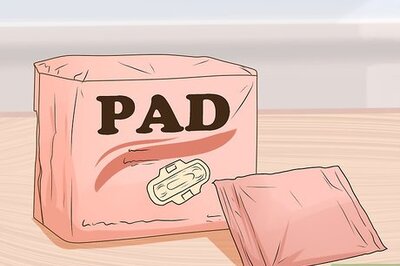
Comments
0 comment